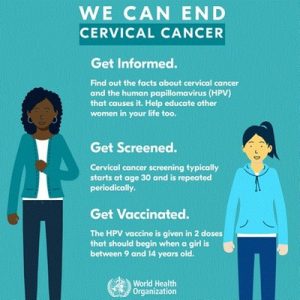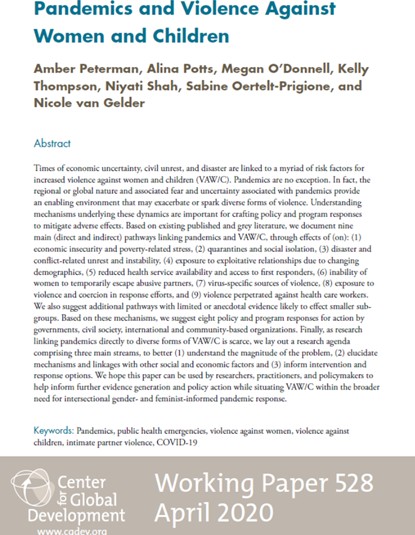Cervical Cancer – Facts & Prevention

WHO – World Health Organization – Cervical cancer (who.int)
Website offers UN official language translations.
22 February 2022
Key Facts
- Cervical cancer is the fourth most common cancer among women globally, with an estimated 604 000 new cases and 342 000 deaths in 2020. About 90% of the new cases and deaths worldwide in 2020 occurred in low- and middle-income countries (1).
- Two human papillomavirus (HPV) types (16 and 18) are responsible for nearly 50% of high grade cervical pre-cancers
- HPV is mainly transmitted through sexual contact and most people are infected with HPV shortly after the onset of sexual activity. More than 90% of them clear the infection eventually.
- Women living with HIV are 6 times more likely to develop cervical cancer compared to women without HIV.
- Vaccination against HPV and screening and treatment of pre-cancer lesions is a cost-effective way to prevent cervical cancer.
- Cervical cancer can be cured if diagnosed at an early stage and treated promptly.
- Comprehensive cervical cancer control includes primary prevention (vaccination against HPV), secondary prevention (screening and treatment of pre-cancerous lesions), tertiary prevention (diagnosis and treatment of invasive cervical cancer) and palliative care.
Overview
Worldwide, cervical cancer is the fourth most frequent cancer in women with an estimated 604 000 new cases in 2020. Of the estimated 342,000 deaths from cervical cancer in 2020, about 90% of these occur in low- and middle-income countries. Women living with HIV are 6 times more likely to develop cervical cancer compared to women without HIV, and an estimated 5% of all cervical cancer cases are attributable to HIV (2). Moreover, in all world regions the contribution of HIV to cervical cancer falls disproportionately on younger women.
In high-income countries, programmes are in place which enable girls to be vaccinated against HPV and women to get screened regularly and treated adequately. Screening allows pre-cancerous lesions to be identified at stages when they can easily be treated.
In low-and middle-income countries, there is limited access to these preventative measures and cervical cancer is often not identified until it has further advanced and symptoms develop. In addition, access to treatment of cancerous lesions (for example, cancer surgery, radiotherapy and chemotherapy) may be limited, resulting in a higher rate of death from cervical cancer in these countries.
The high mortality rate from cervical cancer globally (age standardized rate among women: 13.3/100 000 in 2020) could be reduced by effective interventions at different stages of life.
HPV and cervical Cancer
A large majority of cervical cancer (more than 95%) is due to the human papillomavirus (HPV).
HPV is the most common viral infection of the reproductive tract. Most sexually active women and men will be infected at some point in their lives, and some may be repeatedly infected. More than 90% of the infected populations eventually clear the infection.
Cervical cancer is by far the most common HPV-related disease. Nearly all cases of cervical cancer can be attributed to HPV infection.
Although most HPV infections clear up on their own and most pre-cancerous lesions resolve spontaneously, there is a risk for all women that HPV infection may become chronic and pre-cancerous lesions progress to invasive cervical cancer.
It takes 15 to 20 years for cervical cancer to develop in women with normal immune systems. It can take only 5 to 10 years in women with weakened immune systems, such as those with untreated HIV infection
Cervical cancer control: A comprehensive approach
The Global strategy towards eliminating cervical cancer as a public health problem, adopted by the World Health Assembly in 2020, recommends a comprehensive approach to cervical cancer prevention and control. The recommended actions include interventions across the life course.
The life-course approach for cervical cancer prevention and control
|
Primary prevention |
Secondary prevention |
Tertiary prevention |
| Girls 9-14 years
|
From 30 years of age for women from the general population and 25 years of age for women living with HIV | All women as needed |
Girls and boys should also be offered, as appropriate
|
|
Treatment of invasive cancer at any age
|
Cervical cancer prevention should encompass a multidisciplinary, including components from community education, social mobilization, vaccination, screening, treatment and palliative care.
HPV vaccination
There are currently 4 vaccines that have been prequalified by WHO, all protecting against HPV types 16 and 18, which are known to cause at least 70% of cervical cancers. The 9-valent vaccine protects against 5 additional oncogenic HPV types, which cause a further 20% of cervical cancers. Two of the vaccines also protect against HPV types 6 and 11, which cause anogenital warts.
Clinical trials and post-marketing surveillance have shown that HPV vaccines are safe and effective in preventing infections with HPV infections, high grade precancerous lesions and invasive cancer (3).
HPV vaccines work best if administered prior to exposure to HPV. Therefore, to prevent cervical cancer WHO recommends vaccinating girls aged 9 to 14 years, when most have not started sexual activity.
Some countries have started to vaccinate boys as the vaccination prevents HPV related cancers in males as well as.
HPV vaccination does not replace cervical cancer screening. In countries where HPV vaccine is introduced, screening programmes population-based screening programmes are needed to identify and treat cervical pre-cancer and cancer to reduce cervical cancer incidence and deaths.
Screening and treatment of cervical pre-cancer lesions
Screening
Cervical cancer screening involves testing for HPV infection to detect pre-cancer and cancer, followed by treatment as appropriate. Testing is done among women who have no symptoms and may feel perfectly healthy. When screening detects an HPV infection or pre-cancerous lesions, these can easily be treated and cancer can be avoided. Screening can also detect cancer at an early stage where treatment has a high potential for cure.
With its updated guidelines, WHO now encourages countries to use HPV tests for cervical screening, including HPV DNA and HPV mRNA tests.
- HPV-DNA testing detects high-risk strains of HPV, which cause almost all cervical cancers.
- HPV mRNA detects HPV infections leading to cellular transformation.
Unlike tests that rely on visual inspection, HPV-testing is an objective test. It has been shown to be simpler, prevents more pre-cancers and cancer, and saves more lives. It is also more cost-effective than visual inspection techniques or cytology (commonly known as ‘pap smears’).
Screening should start from 30 years of age in the general population of women, with regular screening with a validated HPV test every 5 to 10 years, and from 25 years of age for women living with HIV. Women living with HIV also need to be screened more frequently, every 3 to 5 years.
The process for a healthcare provider obtaining a cervical sample is similar with both cytology and HPV testing. However, WHO suggests that self-collected samples can be used when providing HPV DNA testing (this does not apply to HPV mRNA tests). Women need to receive appropriate support to feel confident in managing the process.
Screening must be linked to treatment and management of positive screening tests. HPV positive women may be treated without diagnostic verification in limited resourced settings. A test to triage the HPV positive women (e.g. VIA) is essential for treating HIV positive women.
Treatment of cervical pre-cancer
If treatment of pre-cancer is needed and eligibility criteria are met, ablative treatment with cryotherapy or thermal ablation are recommended. Both treatments are equally effective and safe and can be performed in an outpatient clinic.
In case of non-eligibility for ablative treatment or where there is suspicion of cervical cancer, women need to be referred to the right level of health services, where proper evaluation can be done with a colposcopy and biopsies. Excision treatment (LLETZ) can be offered when appropriate, and in the case of cancer an individual treatment plan is designed depending on the stage of disease, the patient’s medical condition and preferences, and availability of health system resources.
Management of invasive cervical cancer
When a woman presents symptoms of suspicion for cervical cancer, she must be referred to an appropriate facility for further evaluation, diagnosis and treatment.
Symptoms of early-stage cervical cancer may include:
- irregular blood spotting or light bleeding between periods in women of reproductive age;
- postmenopausal spotting or bleeding;
- bleeding after sexual intercourse; and
- increased vaginal discharge, sometimes foul smelling.
As cervical cancer advances, more severe symptoms may appear including:
- persistent back, leg or pelvic pain;
- weight loss, fatigue, loss of appetite;
- foul-smell discharge and vaginal discomfort; and
- swelling of a leg or both lower extremities.
Other severe symptoms may arise at advanced stages depending on which organs the cancer has spread to.
Diagnosis of cervical cancer must be made by histopathologic examination. Staging is done based on tumour size and spread of the disease. The treatment plan depends on the stage of the disease and options include surgery, radiotherapy and chemotherapy. Palliative care is also an essential element of cancer management to relieve unnecessary pain and suffering due to the disease.
WHO response
The World Health Assembly adopted the global strategy to accelerate the elimination of cervical cancer as a public health problem. The definition of elimination of cervical cancer has been set up as a country reaching the threshold of less than 4 cases of cervical cancer per 100 000 women per year. To reach this threshold by the end of 21st century, WHO has set up the 90-70-90 targets to be reached by 2030 and to be maintained (WHA 73.2) (4).
- 90% of girls fully vaccinated with HPV vaccine by age 15;
- 70% of women are screened with a high-performance test by 35, and again by 45 years of age.; and
- 90% of women identified with cervical disease receive treatment (90% of women with pre-cancer treated; 90% of women with invasive cancer managed).
WHO has developed guidance and tools on how to prevent and control cervical cancer through vaccination, screening and treatment, management of invasive cancer. WHO works with countries and partners to develop and implement comprehensive programmes in line with the global strategy.
Извор: WUNRN – 14.04.2022



